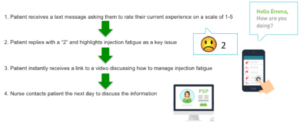Two Promising Strategies to Leverage Real-Time Digital Data to Improve Patient Marketing
By Gregg Fisher
Managing Partner, The Stem
The smartest marketers know that marketing in a digital age should not feel like marketing at all. It should feel like a personal service – relevant, supportive and useful, an authentic blend of customer and brand interests.
Harnessing digital data is a key ingredient in providing exceptional service online. We know this intuitively through our experience as online consumers. And yet for most pharmaceutical patient marketers, tapping digital data is largely unexplored territory.
Here, then, are two promising applications of digital data to improve patient marketing, plus a third “low-hanging fruit” tactic most brands should explore.
- Social customer service (in near-real time)
The airline industry was one of the first to creatively apply social data to boost customer service. If you’re on a JetBlue flight, for instance, and Tweet a complaint, you can expect a response within 5 minutes and 36 seconds on average. And JetBlue don’t just answer users who directly mention its name in tweets, but also respond to tweets that mention the keywords[1]
Now, compare that to a patient’s experience with the pharmaceutical industry. Every day patients make comments and complaints about medical products. In fact, there are over 40,000 conversations on the Web related to drugs and conditions, according to Treato.
Furthermore, a recent study in the multiple sclerosis area found that patients’ social commentary was a leading indicator of future switching behavior. But the voice of pharmaceutical companies is conspicuously absent.
A well-planned social intervention from a pharmaceutical patient support program team could help patients get support to manage side effects or injection fatigue. It could also facilitate acquisition, for instance, by helping patients to enroll in a co-pay program, a patient assistance program or even by introducing a patient with prior experience with a medicine.
There are of course barriers to implementing programs like this (adverse events reporting procedures, staff training, social listening set-up) but in our experience these barriers are surmountable and in many therapeutic categories the benefits of saving even ten patients a year outweigh the costs.
For inspiration, check out Medtronic Diabetes who is a pioneer in social media outreach and regularly intervenes in social networks to provide near real-time patient support.
- Proactive data-driven mobile interventions
Patient support programs (PSPs) are becoming increasingly important differentiators for brands competing in chronic disease areas. Many PSPs have taken steps to “digitize” what has historically been a call-center-driven approach. This typically starts with basic Web information about the value of the program. More developed programs evolves to offer patients self-service tools and to enable nurses or case managers to reactively push information to patients through electronic channels.
An exciting opportunity that is frequently overlooked is leveraging a regular stream of patient feedback to proactively intervene at the precise moment patients need help. Imagine the following scenario:
The idea is to move beyond reactive service to proactive service and to extend in a personalized way the finite capacity of PSP personnel. We have witnessed compelling results from this strategy working with our partners. The technology to do it is here and it’s not as complicated as you might imagine to implement.
- Auditing 3rd party site editorial – “low hanging fruit”
Finally, think about an even more elementary use of digital information to improve patient service: auditing and correcting brand-related information on third party sites. Technically, information on third party sites is not “data” in a strict sense, but it nonetheless shapes patients perceptions of your brand. Most brand marketers are so focused on their “owned media” (e.g., patient Web sites) and “paid media” (e.g., sponsored content) that they miss the low hanging fruit of what’s being written about them. And very often what’s written is inaccurate or incomplete. Third party sites will almost always get more traffic than owned properties so correcting misinformation or providing a more complete set of facts should be a priority.
Wikipedia is one the first places brand teams should start because patients regularly use it as source of information about medicines, but any high-traffic Web site, blog or community is potential territory for correcting third party information. There are certainly tricks of the trade in terms of compliantly and effectively approaching third party sites but our experience shows its works. Information outlets want to supply accurate balanced information and along as the amended information meets that standard many outlets will help.
These are but three ideas. We’d love to hear from you. What are you doing to make your patient marketing feel more like a personal service? How are you applying digital data to offer better service?
About the Author
Gregg is Managing Partner at The Stem, a management consulting firm specializing in digital strategy, engagement and operations. The Stem provides Health brands with specialized expertise in market research, multi-channel strategy, analytics and project management through an innovative “networked consulting” model that draws on the industry’s leading talent. Gregg has 20+ years of experience at the intersection of digital marketing, media and technology. He is passionate about showing how digital technology can make healthcare customer engagement more efficient and effective.
Previously, Gregg was Global Managing Director of LBi Health (now part of DigitasLBi), a digital health agency he founded in 2009. In this capacity, he led the firm’s relationships with major healthcare organizations, including Bristol-Myers Squibb, WebMD, Massachusetts General Hospital, Genzyme and Johnson & Johnson. Prior to that, he was Client Partner and Director of Strategy at IconNicholson, a pioneering interactive user experience and design boutique. He previously served in account management roles at Modem Media, one of the first digital agencies, and BBDO.




